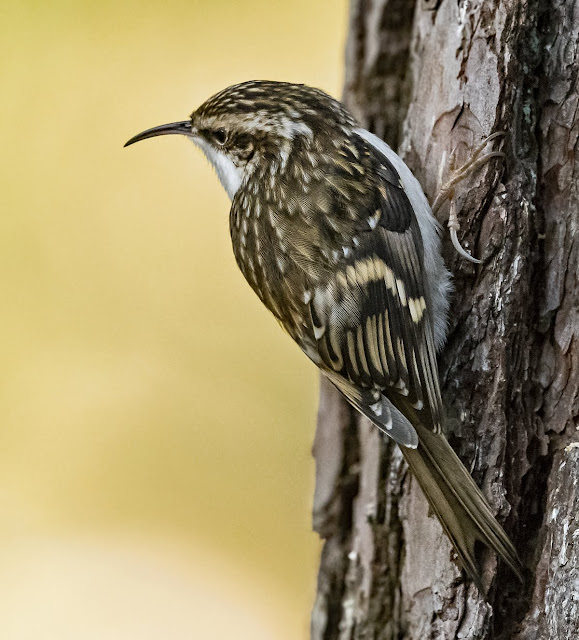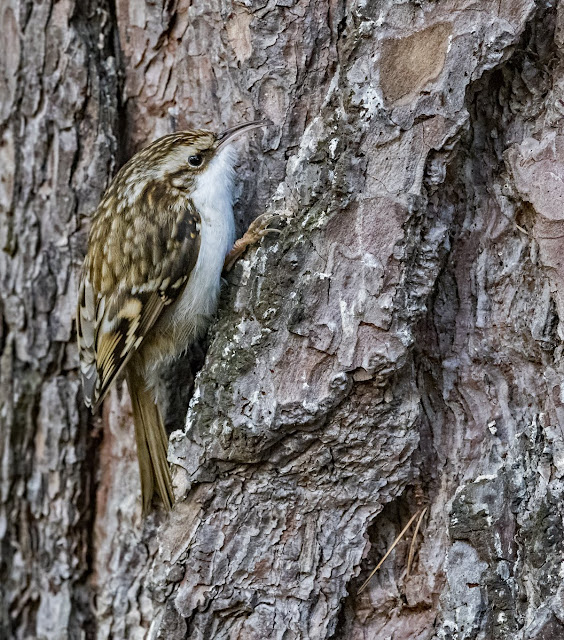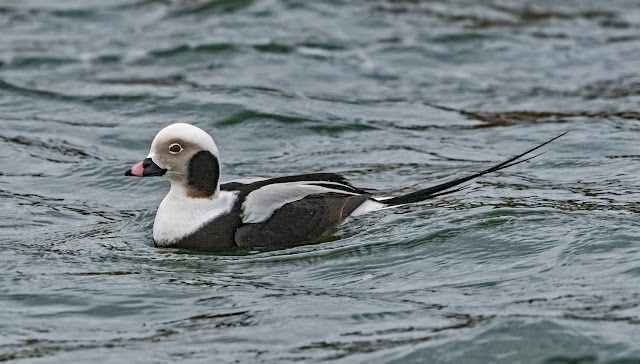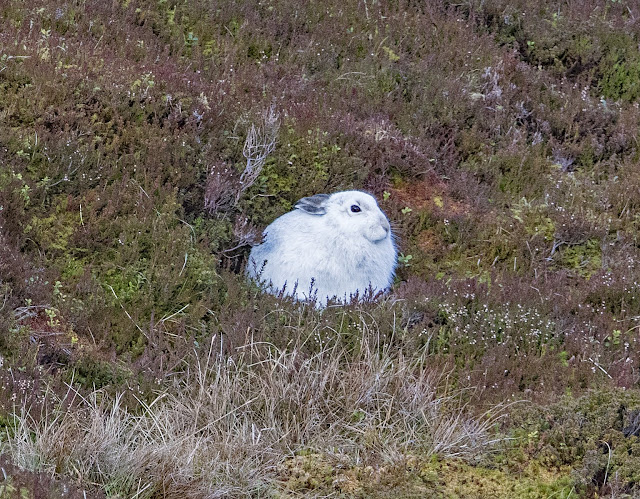I had booked a couple of things in advance - a day trip with a local guide to the Caledonian pine forests around Rothiemurchus in search of Capercaillie and an evening visit to a hide to hopefully see wild Pine Martens and Badgers. Neither of these turned out to be very successful although we did get a five minute view of a young Pine Marten after waiting nearly three hours to see it.
Day 1
This day was mainly concerned with the journey up to Grantown but we did call in at the Cairngorm Ski Centre to look for the famous Snow Buntings on the car park as well as the Loch Garten car park to look for Crested Tits which are often photographed there - no joy on either I'm afraid. We did have a nice chip butty tea in Grantown (pronounced Grantun by the locals) though.
We stayed at the very grand-looking Craiglynne Hotel, a large rambling building with 56 rooms and only eight guests. Like many hotels of this age, it was well past it best with most of the furniture and carpets being very tired. It must very difficult for large places like this to keep going, especially in the winter and it clearly owed some of its past history to the single malt whisky-drinking hunting, shooting and fishing brigade. Nevertheless the staff were very nice, the room was OK and breakfasts were good - good value for money.
Day 2
This was taken up my trip out with a guide to look for Capercaillie. I was picked up at the hotel at 8:15am and so Sarah had the car to go exploring around Carrbridge - I think she had a better day than I did as she came back exhausted having done around a ten mile walk. My day involved walking slowly through the pine forest looking up at trees where the guide has had a good success rate in finding Capers in the past, but although we visited two areas with the right habitat for them, none were seen and this was very disappointing as it would have been a lifer for me. This was the only photo I took all day - good Capercaillie habitat, but none about!
Day 3
Today was our first day out together exploring the area to the the north of the Cairngorms National Park. We started in Anagach Woods near Grantown where the guide had suggested we'd find Crested Tits and Red Squirrels and indeed we did, although only one Crestie and two or three squirrels.
The favoured area was at some feeders in the woods, but the area was very dark and the birds moved very quickly without settling for long. It was 'Coal Tit City' here, with up twenty or more of them constantly flitting around whilst I awaited the lone Crested Tit to return every 15 minutes or so.
The Treecreeper shot above is one of my favourite photos from the week. I love the plumage detail on these little 'tree-mice' as well as the textures of the pine tree bark.
We then moved on to the picturesque Lochindorb to look for Red Grouse and perhaps Black-throated Divers and Raptors. The grouse were all over the place, but we didn't see anything else apart from a few distant Goldeneyes on the loch. Here's a photo of the Famous One, can you feel yourself humming that tune?
 Below is the Red Grouse hen which doesn't have the fancy eyebrows and 'ears' and which is slightly redder in colour - hence it's not quite as famous!
Below is the Red Grouse hen which doesn't have the fancy eyebrows and 'ears' and which is slightly redder in colour - hence it's not quite as famous!
Our next stop was Strathdearn, known erroneously by many as the Findhorn Valley. I'm told that the reason for this is that the area was given this name in a famous birding book because the River Findhorn flows through it, and the name has stuck. However, it is nowhere near Findhorn Bay which is where the river flows out into the sea on the northern coast of Moray.
It was here that we had our first glimpse of a Mountain Hare in its full winter coat. I spent half an hour looking through my binoculars and scope whilst Sarah went for a short walk to the properties at the end of the road. Although there was no snow (unlike last time I was here when I climbed a slope to get some close photos), finding them was made very difficult by the many white lichen marks and quartz veins in the rocks. I still hadn't found one when Sarah returned, but within five minutes or so my eagle-eyed wife had got one in the scope. Well done you!
I then regaled the tale that I tell everyone of how I met Iolo Williams here when he was guiding a party of people, many of whom seemed disinterested and more concerned with having a fag and a cup of tea. Iolo pointed out a Mountain Hare in much the same place as this one, although it was in the snow and much harder to see, and he let me use his scope to view it - we had a short chat and he seemed a very nice chap.
Our last stop for the day was at a Pine Marten hide near Aviemore, so we took the opportunity of having a Costa coffee and cake and going to the toilets in the town, before heading off in the dark into the pine forest on the Rothiemurchus Estate to a viewing hide. I'm not a fan of hides, and I don't normally like paying for viewing wildlife (especially as you always run the risk of a no-show), but there are some things that you can't easily see any other way and so I but the bullet and coughed up for this one.
And so we waited, and waited and waited ... After two and a half hours I was actually hoping for a no-show so that we could could back for free on another night. But after nearly three hours of waiting in the hide, a young female eventually appeared ten minutes before we were due to leave, and so we have to call that a success, although I'm not happy with any of the photos I took during its very brief visit.

Day 4
We had this day to ourselves with no commitments to be back at any particular time and so I chose to go to the Moray coast at Burghead and Findhorn Bay. But first we returned to Anagach Woods to try for some better Crested Tit shots. This time I took some food and poles on which to hang a fat candle in the hope of attracting the birds to a fixed location making them easier to photograph.
Again I think that there was only one Crested Tit about and, as you can see, I didn't really get any better shots but the Treecreeper put in another appearance so I went for that.
And then onto Burghead, which is a small headland which sticks out into the Moray Firth, making it a good place for seawatching. The rain came down as we arrived, so our first views were though the car windscreen whilst intermittently using the wipers. We soon spotted male and female Long-tailed Ducks, Shags, plenty of male and female Eiders and a few Gulls. Later we saw a Red-breasted Merganser pair and at least three Red-throated Divers. This Redshank came in very close below me and so it would have been rude not to photograph it. There was a flypast by a small Common Scoter flock which included a few Velvet Scoters with their white wing bars and a couple of Grey Seals also put in appearance a little later.
We finished off here by driving round to Burghead Harbour where I managed to take the best photo of the week in my opinion - a drake Long-tailed Duck in breeding plumage which came part way in to the harbour and very close.
From Burghead we went westwards along the coast to Findhorn Bay where we had a quick walk to the the beach on the seaward side of the Bay and then a drive round to the dunes in Burghead Bay. Birds of note here were a Little Grebe, a drake Goosander and a Hooded Crow as well as several Cormorants.
As a reward for our efforts, we decided to have a buffet meal at the Taverna in Aviemore for supper.
Day 5
I decided that we'd pay another quick visit to the main car park at Loch Garten on the way to our target for the day, which was walk up to Coire an t'Sneachda which I'd first visited in 2016 to look for Ptarmigan and Snow Buntings. At Loch Garten I only saw one Crested Tit briefly but I was pleased to get a female Brambling in amongst the Chaffinches. We also had fun getting the Coal Tits to feed out of our hands.
Loch Garten has been ravished by so-called photographers doing all sorts of dubious things to get their shots including plastering the trees with peanut butter and even spraying fake snow on the the trees. There are now notices up to ask people to stop doing this type of thing, but putting a little seed down is OK in my opinion.
The birds here are very tame and will feed out of your hand as both Sarah and I found out when we tried. Coal Tits were the bravest with their tiny sharp claws gripping your skin to support their amazingly light bodies, but Great Tits and Robins also joined in. The Chaffinches seemed a lot more wary for some reason. Here's one that Sarah is feeding.
One bird that definitely won't feed out of your hand is the Great Spotted Woodpecker, which flies off as soon as you turn your head and always seems to manage to be on the other side of the tree. It was still great to see one just before we left.
 At the Cairngorm Ski Centre car park I only had one brief view of a Snow Bunting as it flew away from me whilst I was ascending the steps to the picnic table area. I took some sunflower hearts to put down but soon discovered that there was tons of the stuff all along the tops of the walls and even on some tables. Some of it was very wet and had probably been around for a couple of days, although there was none there on my first visit on Monday. They obviously weren't going hungry and many must have gone down to the coasts where they're often seen in winter.
At the Cairngorm Ski Centre car park I only had one brief view of a Snow Bunting as it flew away from me whilst I was ascending the steps to the picnic table area. I took some sunflower hearts to put down but soon discovered that there was tons of the stuff all along the tops of the walls and even on some tables. Some of it was very wet and had probably been around for a couple of days, although there was none there on my first visit on Monday. They obviously weren't going hungry and many must have gone down to the coasts where they're often seen in winter.As we walked along he well defined pathway to Coire an t-Sneachda I told Sarah about the last time I came here when it was deep in snow. If I hadn't been with someone who knew the way I wouldn't have known where to tread or go and this could have been dangerous with all the water channels and streams crossing the path. But this was going to be easy, wasn't it - er, no!
After twenty minutes of walking we notice other people higher up to our left and a choice of paths to our right. We decided to have a look at the OS Maps app we have on both our phones. It was only then that we discovered that there were three possible routes which branched out from the initial path, and we were on the worst one. Of course I didn't know this as last time I was here the whole area was covered in snow and I couldn't see any paths at all. Fortunately we could cut across to another route and continue, but after doing this for about ten minutes we decided to have a look at the map again.
By now we could make out that there was a much higher path along the valley side and that was the one we should have been on. But to get up to it would have been very difficult from our current position, so we decided to continue where we were headed for now. As it happened I knew this would be OK as it was Coire an Lochain at the top because someone had reported Ptarmigan there last week.
We continued for another hour and a half before deciding the mist and light rain wasn't going to clear, so we wouldn't be able to see anything if we got to the Loch. And so after a bite to eat, we returned the way we came to return to the car park. Although there were no birds to see here except a few Red Grouse, the scenery was stunning and we enjoyed ourself.
After getting diesel in Aviemore we set off at about 3:45pm and it was soon going dark as we travelled down the A9 towards Blairgowrie and tea at the Royal Hotel.
Day 6
After a very quick and unsuccessful look for some Waxwings which had been reported in Blairgowrie this week, we headed off on the lovely drive to Glenshee. This was mainly to be a fact-finding mission to get the lay of the land and we already knew there was no snow to speak of in the glen. I was fairly confident of seeing Mountain Hares as they are plentiful around the Ski Centre here, but what I really wanted was to see some Ptarmigan.
I got some good information about where things were likely to be seen from Jason in the tea@theshee cafe and soon we were heading off up the steep slope to a very specific 'Chairlift Pylon Number 7' near which Jason informed me that Ptarmigan had bred this last year. It wasn't very far, but some of it was tough going for me being old and fat, not to mention carrying a big camera.
On the way up we had our first glimpse of a Mountain Hare, but as I got my camera out of the rucksack it ran. I was going to have to be a lot more careful if I had another encounter. We didn't see any more for a while and no Ptarmigan around the rockier areas near the Pylon, but the views were simply breathtaking.
 We'd taken a reasonably direct route up the slope to Pylon 7 and some of it was covered in loose rock on which it was easy to slip, so we looked for a gentler way down. It was whilst doing this that we started to spot more and more Hares - at one point we had eight Hares altogether in our bins and there might have been as many as twelve in total.
We'd taken a reasonably direct route up the slope to Pylon 7 and some of it was covered in loose rock on which it was easy to slip, so we looked for a gentler way down. It was whilst doing this that we started to spot more and more Hares - at one point we had eight Hares altogether in our bins and there might have been as many as twelve in total.As there was virtually no snow anywhere except for a few very small patches on the highest peaks, finding the Hares was quite easy here, especially when they moved. They were mainly sitting in heather patches rather than in amongst the rocks and so, unlike in Strathdearn, there were no patches of lichen or quartz veins to confuse the issue.
I really do need to come back and spend a day here photographing them in the snow and trying to get a lot closer, but for this week, I was very happy to finish on a 'high'.
So looking back on it perhaps the photos aren't that bad after all, there's certainly a variety of animals in there and we had a good time discovering new places in a fabulous part of the world. We'll just have to go back!



































Nice report. Seems from past experience that to see the birds the colder it is the better. Reckon the Caper is the birding version of Nessie.
ReplyDelete